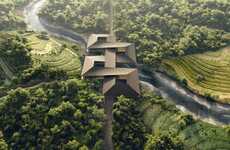
The Biophilic Leadership Summit is Surrounded by Greenery
Amy Duong — May 16, 2023 — Art & Design
References: redirect.viglink & design-milk
The Biophilic Leadership Summit in the Serenbe community in Georgia took place in April and it welcomed researchers and practitioners from various fields. This includes "architecture, landscape design, horticulture, education, urban planning, governance, and the neurosciences." They all face challenges and look for solutions within the realms of housing, health, and the environment.
The Serenbe community functions as a developing project and is also an established example of bioliphic design pushed towards action -- the space is also residential which isn't new at all. It is an interconnected network of homes, community centers, a working farm, parks, and small businesses. Overall, the Serenbe gives off a nostalgic and idyllic energy similar to a small English countryside town.
Image Credit: Serenbe
The Serenbe community functions as a developing project and is also an established example of bioliphic design pushed towards action -- the space is also residential which isn't new at all. It is an interconnected network of homes, community centers, a working farm, parks, and small businesses. Overall, the Serenbe gives off a nostalgic and idyllic energy similar to a small English countryside town.
Image Credit: Serenbe
Trend Themes
1. Biophilic Design - The concept of Biophilic Serene Communities can be applied to various industries including architecture, interior design, and urban planning.
2. Sustainable Living - Creating sustainable living spaces is a top trend in the housing industry, where Biophilic design can play a significant role in creating eco-friendly homes and communities.
3. Green Urbanism - Urban planning professionals can take note of the Biophilic Leadership Summit as a model for creating green urban spaces and communities.
Industry Implications
1. Architecture - Architecture firms can incorporate Biophilic design elements to create housing and commercial projects that prioritize occupant well-being and environmental sustainability.
2. Interior Design - Interior designers can use Biophilic design to bring natural elements inside residential and commercial spaces to create calming and productive environments.
3. Urban Planning - Urban planners can use Biophilic design to create green and sustainable urban spaces, which may foster community engagement and environmental conservation.
3
Score
Popularity
Activity
Freshness
























